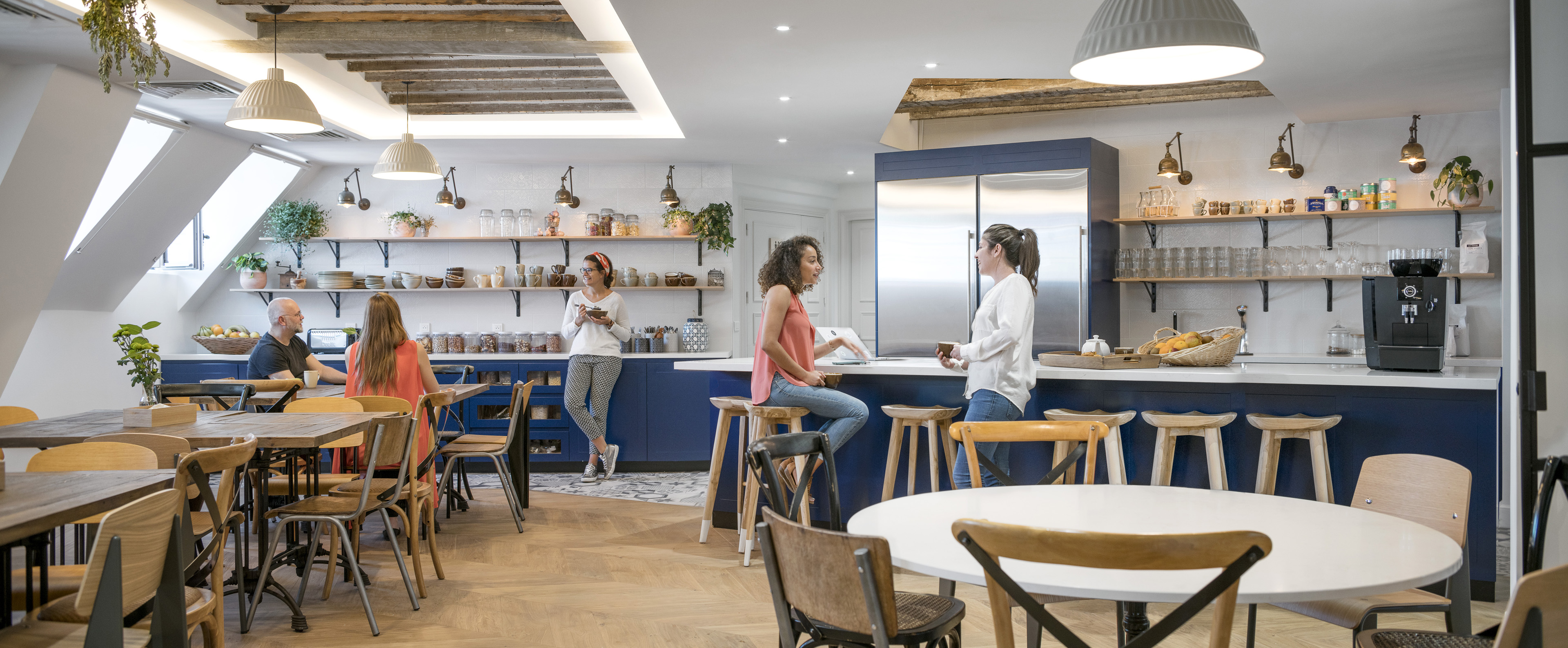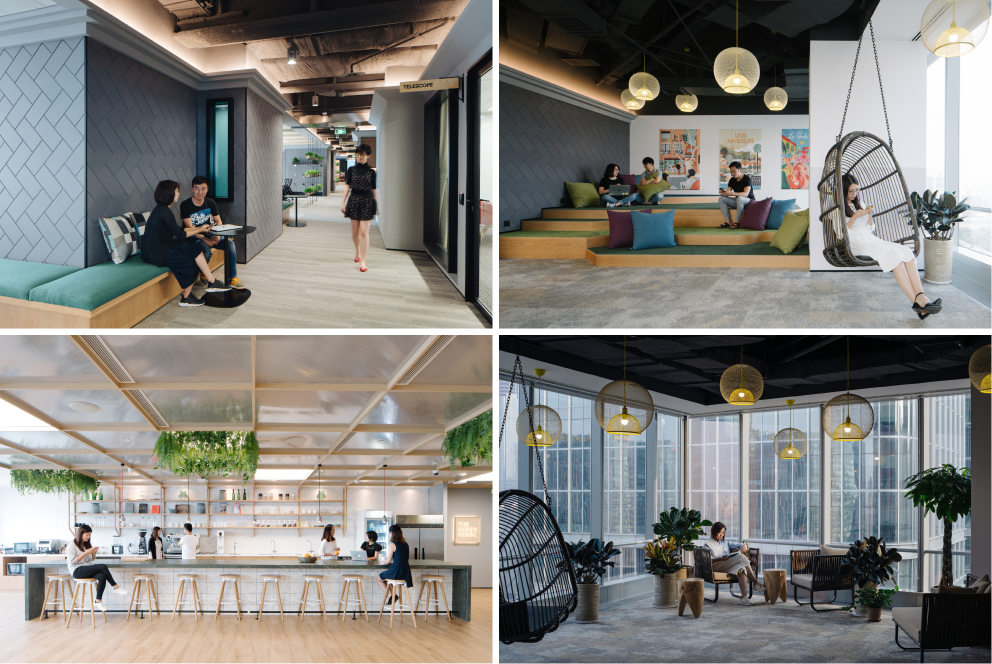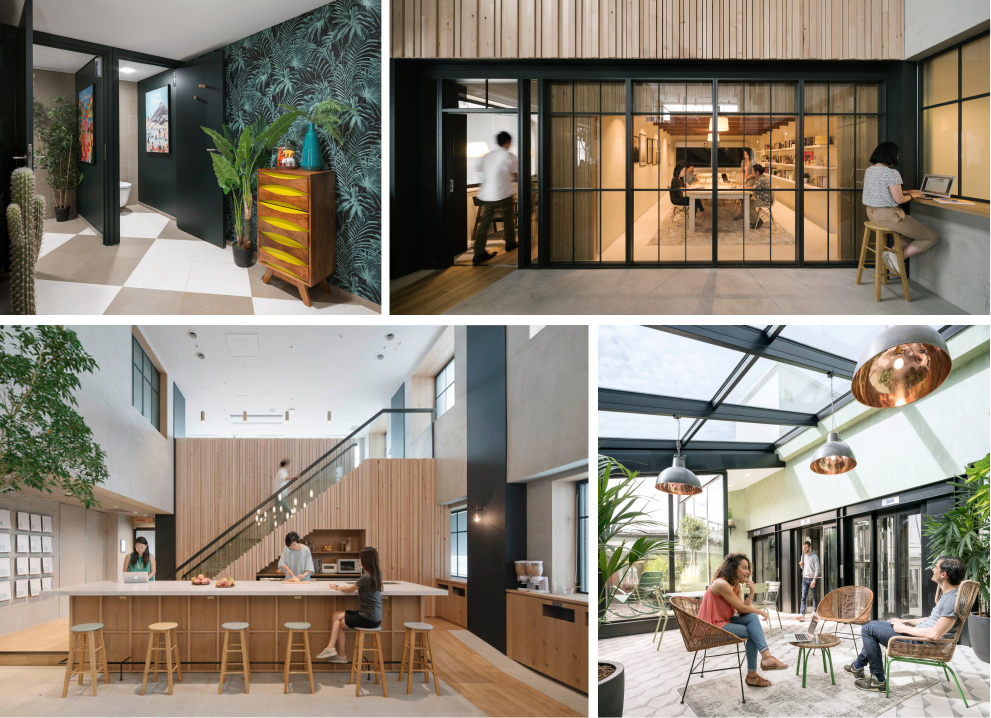Worldly Workspaces
Approaching interior design through a cultural lens
“People don’t often realize it,” says Rebecca Fairman, “but every space we encounter affects us physically, mentally, and emotionally.” As an Interior Design Manager, Rebecca has spent the past four years designing Airbnb offices around the world, translating the brand and company culture into functional (and, in the team’s words, “seriously fun”) physical environments. Here, Rebecca tells us more about her team’s carefully crafted, culturally specific approach to office design—and why culturally differentiated workplaces have helped employees around the globe do their best work.
Many people don’t know that Airbnb has an in-house interior design (or Environments) team. Why is a thoughtful approach to space important here?
In general, space is important to us because Airbnb is not just a digital booking platform. It’s a hospitality company where places to stay and experiences are our product. Our community experiences our brand across various mediums including the platform. From our app to our website to the physical space of a host home, we design across surfaces. It makes sense that our offices reflect the same thought and care that we put into that product.
Many large companies have design or real estate project managers who partner with outside consultants in each of their project locations. So it’s quite unique to have an in-house design team of full-time architects and interior designers, like we do at Airbnb.
Our founders studied design themselves at RISD, so they’ve always understood its value and necessity in building a strong company. Design is foundational to everything we do at Airbnb, and therefore it makes logical sense to have an internal group who understands our culture in a way that an outside consultant never could. Our team can translate our values and our brand into physical space in a way that feels intrinsic rather than cosmetic. We still partner with some outside consultants, but our internal perspective sets each project up for success, and allows us to do it at a faster pace since there’s no learning curve.

Airbnb’s San Francisco office on Brannan Street. Photograph by Mariko Reed.
Airbnb homes can be found all over the globe. Does the Airbnb community’s approach to space have any influence on how you approach workplace design?
Absolutely! What makes Airbnb so special is our hosts. Each one has a different story to tell and their unique perspective is clearly visible in the design of their home. Airbnb Plus demonstrates that very clearly. To qualify for the program, your home must highlight your unique personality, identity, and individuality as a host. It’s important to us to not only differentiate ourselves in the hospitality market, but also to showcase how culturally rich and diverse our homes are. Airbnb hosts hail from 190+ countries and that diversity is reflected in the ways they choose to design their homes. Our approach to diverse workspaces is rooted in the same idea. It begins with our community and expands to our employees. We want to remind employees each day of our global mindset and our office spaces help us do that.
When you’re approaching the design of an Airbnb office, what are some of your guiding philosophies—and what is your process like?
We evaluate each project through three lenses: Airbnb culture, local culture, and local business needs. It’s important for each space to reflect who we are as a company, but it’s equally important that it support and celebrate the local team and culture surrounding it.
That’s key when it comes to helping people feel comfortable in the space, feel represented, and, ultimately, to feel that they belong.
So we dedicate a lot of time to research. The Environments team acts as the Airbnb culture expert, but we rely on our teammates in each city to be our local experts. We ask them to take us around and share their favorite foods, spaces, destinations, and things to do. That research gives us great insight into what makes this location unique and what special details and elements we might want to highlight in the new space. We also work with a local architect, who can share resources for local furniture and lighting, in addition to insights on indigenous materials. We do our best to use as many local resources as possible, so the end product feels as authentic as possible.
We also review the business needs of each location. Each office has different teams, focuses, and ways of working, which we learn about through surveys, interviews, and observation. In Portland, we noticed many employees biked to work and kept their helmets on their desks. It was clear they needed personal storage to keep the space organized and clutter at bay. It made us think: How can we adapt the space to accommodate something like this more comfortably?
What are some other concrete ways that you’ve honored and accommodated differences in how teams use space?
Our Paris office is relatively small, and the team there has created a very family-like community. They love to cook together and eat their meals at a large communal table. In their free time, they love scouring the local flea markets for vintage finds. So we designed their office to feel like a residential Parisian attic loft with an eclectic mix of vintage and modern furniture, and a big open kitchen at its heart.
Their business needs were also very specific. They host a lot of public-facing events and prefer to work casually on their laptops rather than at standing-height desks. So we created a hospitality lounge for visitors, and lots of cozy areas for solo and group work time. A lot of thought went into even the smallest details; for example, the walls in some of the rooms are paneled with what looks like traditional French molding, but those are actually acoustic panels that help keep the volume controlled when people are meeting or talking on the phone. As a whole, the look of the space is very Parisian, but more importantly, it still feels like Airbnb.

The Paris office. Photograph by Donal Murphy.
In Beijing, we wanted to incorporate a sense of “old meets new,” to reflect both the city’s modernity and its history. In a nod to the older architecture found in the Hutong neighborhoods, we outfitted the walls with paneling that resembles the brick found in those areas. In homage to traditional local practices, there are areas to store your shoes and change into slippers when you arrive; spaces to nap after lunch, which is common practice there; and the entire office is designed around the principles of feng shui.
Additionally, given the city’s issues with pollution, employees in Beijing are very focused on indoor air quality, so we created a green oasis with lots of plants and a state-of-the-art mechanical system to clean the air. The office is also a growing engineering hub, and they’re often giving tours for potential job candidates and government officials. So there’s a clear line of separation between the open office and the circulation paths for tours, so guests can visit without disturbing employees.

“Old meets new” at Airbnb’s Beijing office. Photograph by Mariko Reed.
Can you elaborate on how you make sure each office stays true to the look and feel of Airbnb, despite various cultural differences?
There are a few touchpoints we adhere to in every office, no matter its location. First, we want our designs to reflect and support Airbnb’s mission of belonging anywhere. We do this by creating spaces that support a broad variety of work styles, and by developing solid strategies around shared space. We don’t want employees to feel confined to their desks, so we’ve reduced the footprint of individual desks in favor of expanding collective spaces like lounges, cafes, and amenity areas. All of these spaces are set up with proper power and lighting so that employees can get productive work done, anywhere in our offices.
We also make sure to include “cultural moments” in each space. When you walk into an Airbnb office, you won’t see the company logo splashed everywhere. Instead, we put up portraits of our hosts, and imagery that spotlights the kinds of trips, experiences, and interactions you can have on Airbnb. When we design a space, our goal is to remind people why they work, not where they work.
Listing rooms are another staple feature. Our company is focused on travel and discovering new places, so we like to give our employees the same opportunity to “travel” and learn about new cities as they work. We do that by theming our meeting rooms after real Airbnb listings.
An element of fun is also prioritized in each space—there’s a workspace in the San Francisco office, for example, that’s built to resemble a houseboat. Why is that important?
We believe that the design should be “seriously fun.” We want to create a draw to come into the office, especially in this day and age, when remote work has become the norm. There are advantages to that, but as a community-focused company, we value in-person interaction. In addition to that, competition for great employees is high, and office amenities play a big role in recruiting. So it’s a priority for us to create spaces that are both fun and functional. For example, that boat is a recreation of a Dutch houseboat on Airbnb. It’s playful, but it serves a purpose: The cabin is a functional meeting room, and it has little cubbies built into both sides where people can comfortably do focused work.

One of Airbnb’s San Francisco offices. Photography by Mariko Reed.
What have been some of the challenges you’ve faced over the course of these various projects? What, if anything, has surprised you?
I’ve been surprised by the global influence of Silicon Valley. We’ve had employees and leadership around the world ask us to match the design of our San Francisco space. While that’s flattering, it’s been surprising that the immediate focus isn’t highlighting what’s special about their own culture.
We’ve pushed through anyway to great success. In Beijing, employees felt that an office that looked like the one in San Francisco would be the best draw for new recruits. But we followed our plan, and the team were ecstatic about the final design. They agreed that they liked it even better than San Francisco, because not only did it look different from their competition, it represented the things that made their city unique. They felt a connection to it and a real pride in their history.
When you design your next global workspace, what elements of the process might you approach differently?
This approach is difficult. It takes time to research, it requires you to be more embedded in the place, visit in person, and spend quality time in that place and connect to locals. It requires working with smaller local companies that may require more hand holding since they’re not used to working at our scale. As project schedules continually get shorter and budgets get tighter, the easier choice is to standardize across all locations and optimize for speed and cost in order to scale, but we believe the value far outweighs the cost. We hope to continue to push the envelope on this and see other companies follow suit.
It would be great if the industry created resources to make it easier to find and work with smaller local vendors and creatives. I’d also love to see Airbnb commit to making a specific percentage of our selections from local and/or diverse suppliers as a new company standard.

Airbnb offices in Paris and Tokyo. Photography by Studio Periphery and Donal Murphy.
Who else is leading the charge when it comes to creating workspaces inspired by the cultures surrounding them?
I’ve always been inspired by the work of Neri & Hu. I’m impressed by their ability to reference historical Chinese concepts and culture, but to consistently present them with a fresh, innovative perspective. They say that they take an approach of reflective nostalgia when embarking on a new project.
Aesop is another great example of a company with a global reach, but with a focus on creating spaces that are respectful of community, culture, and history. They reference local materials, styles, and forms and think of “each city as a living body.” (quote by Augustine of Hippo)
I particularly love how they transparently share the story behind each store as well as links and information about the key features and materials that they highlight on their website called The Taxonomy of Design.
After designing nine international offices, what have been some of the biggest lessons you’ve learned? What advice would you offer to those interested in pursuing similar goals?
It may not be obvious at first, but interior design is one of the ultimate forms of self-expression. When you visit a friend’s home for the first time—without them saying a word—you can learn so much about who they are and what they value, just by walking in the door. Companies have the same opportunity with the design of their offices. It is one of the most impactful ways that you can communicate to employees, visitors, investors, and partners what you value most. It’s your chance to inspire and motivate them, to set them up for creativity, productivity, and happiness. It is one of the most powerful tools you have at your disposal for shaping the company that you envision and sharing that message with the outside world.
My best advice would be that you don’t need to look elsewhere—on Instagram, Pinterest, or at any other company’s offices—to design a great-looking workplace. Letting the needs of your team—and the spirit of your product—dictate the design direction is the best way to create a space that’s beautiful, functional, and 100% unique.